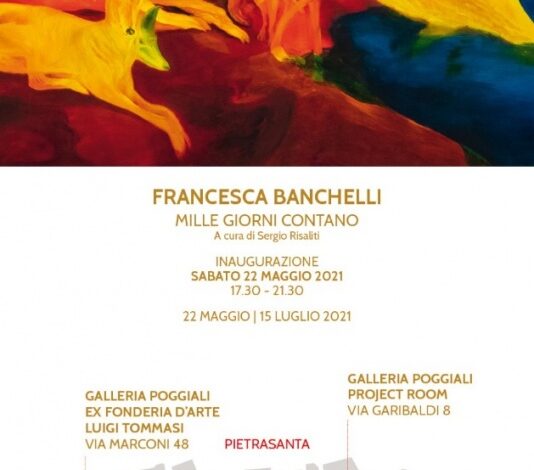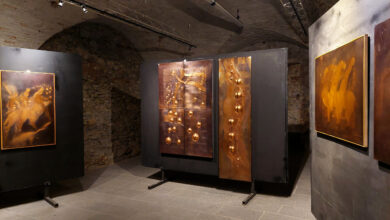Galleria Poggiali Pietrasanta|Domani 22.05.2021 ore 17.30 inaugurazione mostra di Francesca Banchelli “MILLE GIORNI CONTANO”

Francesca Banchelli
MILLE GIORNI CONTANO
a cura di Sergio Risaliti
GALLERIA POGGIALI PIETRASANTA
Inaugurazione sabato 22.05.2021 ore 17.30 | 21.30
22.05.2021 – 15.07.2021
English text below
La Galleria Poggiali di Pietrasanta, apre la stagione estiva delle mostre con una personale di Francesca Banchelli (Montevarchi, 1981) a cura di Sergio Risaliti, Direttore artistico del Museo Novecento di Firenze. L’inaugurazione è fissata per sabato 22 maggio 2021 dalle ore 17.30. Mille giorni contano è il titolo che l’artista ha scelto per presentare i suoi dipinti e le sue sculture – in totale una ventina di opere – che saranno visibili con ingresso libero nella project room di via Garibaldi 8 e nella suggestiva sede dell’Ex-Fonderia d’Arte Luigi Tommasi di via Marconi 48, sempre a Pietrasanta.
Recentemente Francesca Banchelli ha tenuto una mostra al Museo Novecento di Firenze, partecipando al progetto “Duel” in dialogo con un’opera di Scipione, così come ha nel suo palmares importanti apparizioni in istituzioni italiane e straniere come il Museo Pecci a Prato, Villa Romana a Firenze, il Macba di Barcellona, la Tate modern di Londra. La sua ricerca spazia dalla pittura alla scultura, dal disegno alla performance, al video.
I dipinti dell’artista toscana ci invitano a riconsiderare la potenza narrativa della pittura: attratti da una ricerca sul colore nella sua versione magico-espressiva, seguiamo un flusso di apparizioni figurative, uomini, donne, fanciulli, cani, volatili, animali selvatici, che vivono in un mondo naturale, rigoglioso di piante e di acqua, spazzato via da una tempesta, a volte oscuro come in una plumbea notte.
Quelli di Banchelli sono tuttavia paesaggi del profondo, luoghi dell’anima che ospitano esperienze dall’inconscio personale e collettivo. La cronaca, la storia, perfino la vita quotidiana, hanno una loro risonanza archetipica e surreale; l’aneddoto, il ricordo, il dato oggettivo vengono trasfigurati in un immaginario onirico che include nelle sue scene passato e futuro, il remoto e il futuro, l’incognito e la previsione. Sogno, profezia, reminiscenza o prefigurazione la sua poetica attraversa e restituisce un linguaggio pittorico al micro e la macrocosmo, in una dimensione che attraversa il tempo cronologico, tra diurno e notturno. I dipinti allora diventano come rituali in cui la conoscenza più profonda e veggente coincide con la luce del colore e la eloquenza delle figure; il quadro ci parla, sussurra e ci lascia fantasticare offrendoci la possibilità di riattivare le nostre capacità proiettiva, di immaginare e connettere tutto il sapere dell’inconscio con i dati reali, l’anima individuale con l’anima mundi. In questo senso i suoi dipinti sono atti performativi che ci coinvolgono singolarmente e collettivamente. E come ogni rituale o performance le sue opere pittoriche possono servire come esperienza di traslazione e catartica, in quanto hanno una loro natura o potenza demiurgica.
In tal senso i suoi dipinti risultano narrativi, ma solo a un primo livello di lettura. Le sue composizioni ci impongono un approfondimento mentale ed emozionale. Dopo una prima fase di godimento per il tipo di esecuzione – leggera, veloce, intensa, ricca di sfumature – viene da domandarsi quale sia il significato delle singole figure e degli oggetti in scena, e quali i loro nessi. Il racconto sfugge ma sotteso si intuisce. La pittura è ancora cosa mentale, ma di un pensiero dell’immagine che scaturisce dal cuore, dall’immaginario del profondo. La pittura aggiunge qualcosa di specifico, un’alterità che le è propria. Crea mondi e storie che possono essersi esaurite e che stanno per avvenire, magari ripetersi, differenti e inedite.
«La pittura – dice Francesca Banchelli – mi porta ad esplorare dei territori che sono introvabili con gli altri mezzi. La pittura approfondisce e satura immaginari che si sono creati lavorando su concetti e pensieri, immaginari così stabili che ritornano instabili, diventano realtà pronte a schiudersi ed essere raccontate con risvolti impensabili, se non attraverso l’uso della pittura».
I N F O M O S T R A
Francesca Banchelli
Mille giorni contano
A cura di Sergio Risaliti
22.05.2021 | 15.07.2021
Inaugurazione SA 22.05.2021 ore 17.30
Galleria Poggiali Pietrasanta
Project room, Via Garibaldi 8, Pietrasanta
Ex Fonderia d’Arte Luigi Tommasi, Via Marconi 48, Pietrasanta
Ingresso libero
Orari: martedì – domenica 16 – 22
dal 5 giugno 18-24
Sabato – domenica anche 10.30-12.30
cel. +39.334.9236625; tel. 055.287748
www.galleriapoggiali.com
info@galleriapoggiali.com
___°___
Francesca Banchelli
A Thousand Days Count
Curated by Sergio Risaliti
Opening Saturday 22 May 2021
Hours 5.30 p.m. – 9.30 p.m.
22.05.2021 – 15.07.2021
The Galleria Poggiali of Pietrasanta opens the summer exhibition season with a solo show by Francesca Banchelli (Montevarchi, 1981) curated by Sergio Risaliti (opening Saturday 22 May 2021 from 5.30 p.m.). A Thousand Days Count is the title chosen by the artist to present her paintings and sculptures in the project room in Via Garibaldi 8 and in the atmospheric setting of the former Luigi Tommasi artistic foundry.
Francesca Banchelli’s career is already marked by major shows in leading venues both in Italy and abroad, including the Museo Pecci in Prato, Villa Romana in Florence, the MACBA in Barcelona and the Tate Modern in London. Her research spans from painting and drawing to sculpture, performance and video. She recently had a show at the Museo Novecento in Florence, taking part in the Duel project in dialogue with a work by Scipione (Gino Bonichi).
Her paintings invite us to reconsider the narrative power of painting. Attracted by an exploration of colour in its magical-expressive guise, we follow a flow of figurative apparitions – men, women, children, birds and wild animals – living in a natural world amidst a luxuriance of plants and water, swept away by a storm, at times dark as in a leaden night sky. Nevertheless, Banchelli’s landscapes are those of the inner depths, sites of the soul that host experiences of the personal and collective subconscious. Current events, history and even everyday life take on an archetypal and surreal resonance. The anecdote, the memory and the objective datum are transfigured in a dreamlike imaginary that includes in its past and future scenes both the remote past and what is to come, the unknown and the foreseen. Dream, prophecy, reminiscence or prefiguration, her poetics permeates and yields up a micro and macrocosmic pictorial language in a dimension that cuts across the chronology of diurnal and nocturnal time. In this way the paintings become rituals in which the deepest and most prophetic knowledge coincides with the light of the colour and the eloquence of the figures. The painting speaks to us, whispers and allows us to fantasise, giving us the chance to reawaken our capacity for projection, to imagine and connect all the knowledge of the subconscious with the real data, the individual soul with the soul of the world. In this sense Banchelli’s paintings are almost performative actions that engage us individually and collectively. And, like all rituals or performances, her pictorial works can function as an experience of transference and catharsis, since they possess a demiurgical nature or power.
In this respect, Banchelli’s paintings do appear to be narrative, but only at a first level of interpretation. They also demand from us greater mental and emotional exploration. After an initial phase of enjoyment of the type of execution – light, swift, intense and rich in nuance – we ask ourselves about the meaning of the various figures and objects in the scene and the connections between them. The story eludes us, but we implicitly intuit it. The painting is still something mental, but it is a thought of the image that springs from the heart, from the imaginary of the innermost. The painting adds something specific, an alterity that is proper to it. It creates worlds and stories that may be finished and that are about to happen, perhaps repeating themselves, different and original. As Francesca Banchelli herself explains, ‘Painting leads me to explore territories that cannot be reached by other media. Painting explores and fills imaginaries that have been created by working on concepts and thoughts, imaginaries so stable that they become unstable again, become realities ready to open up and be told with implications that would be unthinkable except through the use of painting.’







